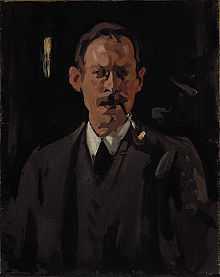Samuel Peploe
| Samuel Peploe | |
|---|---|
 self portrait (1904) | |
| Born |
27 January 1871 Edinburgh |
| Died |
11 October 1935 Edinburgh |

Samuel John Peploe (pronounced like PEP low) (27 January 1871 – 11 October 1935) was a Scottish Post-Impressionist painter, noted for his still life works and for being one of the group of four painters that became known as the Scottish Colourists. The other colourists were John Duncan Fergusson, Francis Cadell and Leslie Hunter.
Biography
Born in Edinburgh, he studied at the Royal Scottish Academy schools from 1893 to 1894, and then at the Académie Julian and Académie Colarossi in Paris, where he shared a room with Robert Brough. He visited Holland in 1895, returning with reproductions of work by Rembrandt and Frans Hals. From 1901, he undertook painting trips to northern France and the Hebrides with his friend J. D. Fergusson, another of the Scottish Colourists. Inspired by the bright sunlight, he experimented with the bold use of colour, and the influence of the rustic realism of French painters, and of the Glasgow Boys, is evident in his landscapes.
Peploe married Margaret McKay in 1910 who he had known since 1894.[1] He also moved to Paris in 1910, a period which saw him concentrate increasingly on still life and landscape painting. His still life works show the influence of Manet, with combinations of fluid brushwork, thick impasto and dark backgrounds with strong lighting. Returning to Scotland in 1912 he found that his usual dealer refused his work and he was obliged to stage his own exhibition.[1] Peploe went on regular painting trips with friends to many parts of the country, and during the 1920s he spent several summers with Francis Cadell, another Scottish Colourist, painting in Iona.
Peploe was strongly influenced by French painting throughout his life. Although his work never became overly abstract, it was notable for its use of strong colour, tight composition, and meticulous execution. Influences are said to include de Segonzac, Cézanne, Matisse and Van Gogh.[1] He died in Edinburgh in 1935. Peploe's younger son Denis followed his father's career.[2]
Peploe's 1905 painting Still Life with Coffee Pot, sold on 26 May 2011 at Christie's in London for £937,250, holds the record for one of the most expensive Scottish painting sold at auction - the most expensive being Peter Doig's White Canoe which sold for 11 million. The previous record for a work by Peploe was £623,650 for Tulips, sold in 2010.[3] In October 2012, a Peploe painting "Pink Roses" sold for £225,000. The painting had been relegated to a spare room because the owner's wife did not like it.[4]
Kirkcaldy Museum and Art Gallery holds the largest collection of Peploe's paintings aside from the National Galleries of Scotland.[5]
In fiction
A painting which might or might not be by Peploe (the question is only resolved at the end of the book) plays a central role in the novel 44 Scotland Street by the Scottish writer Alexander McCall Smith where a grandson of the painter makes a brief appearance. A Peploe painting also plays a small role in the novel Winter Solstice by Rosamunde Pilcher.
References
- ↑ 1.0 1.1 1.2 Biography and works at Portland Gallery, accessed December 2012
- ↑ Michie, David (28 May 1993). "Obituary: Denis Peploe". The Independent. Retrieved 30 December 2012.
- ↑ £1m coffee pot smashes art record, Scotsman.com, 26 May 2011, accessed December 2012
- ↑
- ↑ "Kirkcaldy Museum and Art Gallery info". Fife Council. Retrieved 2012-12-12.
Peploe painting hidden in spare room fetches £225,00 at auction, http://www.bbc.co.uk/news/uk-scotland-tayside-central-20093984
| Wikimedia Commons has media related to Samuel Peploe. |
External links
|